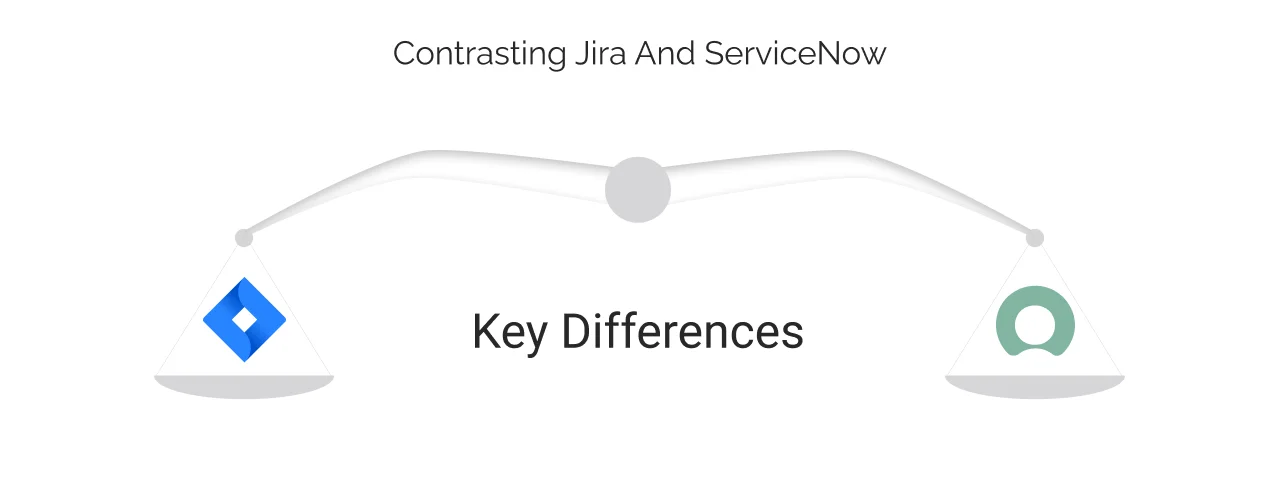Jira vs ServiceNow: How Do They Compare?
Table of Contents
Jira and ServiceNow are two leading enterprise solutions. But how do they compare? This question is not only common but also important considering the integral role these platforms play in the smooth process of businesses across the globe.
Here in this, we’ll discuss how Jira vs ServiceNow compare. These detailed insights will help you choose a platform best suited for your business.
Let’s start with a brief introduction to ServiceNow and Jira.
Jira vs ServiceNow: Brief Overview


Jira was introduced by an Australian-based company, Atlassian in 2002. The first product it introduced was Jira software, a project management tool that acts as a centralized platform for task management, bug tracking, and helping teams organize their tasks according to priority.
Jira expanded its offering to stay relevant in the growing market and become the choice for different industries and teams with diverse needs. Over the years it has introduced products such as Jira Align, Jira Service Management, Jira Work Management, and Jira Product Discovery.
ServiceNow was founded in 2004, and IT Service Management product was its initial offering. Since then ServiceNow expanded its horizon by including products such as ServiceNow ITOM, HR Service Delivery, Customer Service Management, Workplace Service Delivery, Field Service Management, and more.
Jira vs ServiceNow: What are the Similarities?
Jira and ServiceNow both cater to slightly different needs of the organizations. However, they have some functionalities that overlap with each other. Let’s discuss the overlapping functionalities;


IT Service Management
Jira has a product called Jira Service Management (formerly known as Jira Service Desk). This ITSM solution supports IT teams to deliver exceptional service experience for customers and employees alike.
ServiceNow, on the other hand, has ServiceNow IT Service Management products. This is a solution for businesses of all sizes to bring together IT services and tools on a platform to achieve modern IT excellence.
Let’s find out what are the similarities between Jira Service Management vs ServiceNow ITSM;
| Functionalities | Jira Service Management | ServiceNow IT Service Management |
| Incident Management | Bring development and IT teams on the same page to enable rapid, response, and resolution of incidents. | It has intelligent routing and built-in tools to resolve issues promptly and restore services. |
| Request Management | A simple and intuitive portal to enable the employees to get the help they need. | AI-powered self-service portals enable employees to request products or services intuitively. |
| Problem Management | It supports all stages from problem logging, scope, and root cause investigations to resolutions for effective problem management. | A single system of record enables easy identification and addresses issues by minimizing downtime. |
| Knowledge Management | With a vast knowledge base of articles, it surfaces relevant articles to help customers and employees resolve issues themselves. | With a contextual knowledge base driven by AI, it provides proven resolutions to boost self-service. |
| Change Management | By providing full context about the change, it scores the risks involved and configures approval workflows to ensure successful change implementation. | It has built-in AI & risk assessment, data-driven flows, and dynamic approval policies to accelerate the change by delivering value. |
| Asset Management | From tracking assets, and populating asset repositories, to asset recommendations to maximize their value. | It helps throughout the asset lifecycle from procurement, deployment, and maintenance, to retirement. |
| Service Level Agreement | It enables you to define SLAs. | SLAs strengthen the relationship between the service provider and the business by establishing expectations. |
This is just a granular overview of the Jira Service Desk vs ServiceNow ITSM capabilities overlapping with each other. The scope of these functionalities varies between these platforms. We’ll discuss those differences later in this blog.
HR Service Management
Human Resource Service Management (HRSM) functionality is the subset of the Jira Service Management. This helps HR teams manage all their operations, automate repetitive tasks, and more.
ServiceNow has a dedicated product known as ServiceNow HR Service Delivery. It helps businesses manage HR operations such as effective staffing, employee onboarding & offboarding to oversee the performance of workers within the organization.
Let’s see how Jira HR Service Management (HRSM) stacks up against ServiceNow HRSD;
| Functionalities | Jira HR Service Management | ServiceNow HR Service Delivery |
| Employee onboarding & offboarding | It allows you to create workflows for HR processes such as employee onboarding & offboarding. | It also helps HR teams to automate the process of employee onboarding and offboarding. |
| Self-service portals | It has a customizable help center enabling employees to access all organization services, and submit requests, so they can find the help needed themselves. | It allows the creation and configuration of self-service experience to enable employees to avail self-services intuitively. |
| Service Level Agreements (SLAs) | Project admins can define SLA to plan which task should be resolved first and the timeframe in which they can be resolved. | SLA can be created to establish the terms and conditions for HR teams to deliver the help and guidance employees need. |
| Automation | It has low-code or no-code automation capabilities to automate repetitive tasks. | It also has low-code tools powered by GenAI to automate the HR processes. |
Customer Service Management
With Customer Service Management, Jira extends its support from inward operations to outward operations like delivering expectational customer services. It has pre-built customer service templates enabling the support team to manage their work. Its basic functionalities include SLAs, answering customers’ questions, prioritizing inquiries, and collecting customer feedback to deliver exceptional experiences.
ServiceNow has a comprehensive Customer Service Management tool. This is driven by AI-powered self-services enabling users to solve issues quickly and delight customers. Its features include omnichannel customer support, case management, SLAs, issue resolution, knowledge management, and task intelligence.
Agile Project Management
Jira Align helps organizations scale agile practices and improve the communication between business and technology operations to increase the certainty of achieving expected outcomes.
ServiceNow has Agile Development helping organizations to prioritize, plan, and manage projects to support the strategic objective of an organization. Furthermore, it simplifies the execution of projects enabling them to deliver products or services faster.
ServiceNow Agile Development vs Jira Align has some overlapping functionalities related to project management.
Cloud-First Platforms
ServiceNow and Jira both are cloud-first platforms. They come with cloud deployment options that enable you to leverage the scalability of the cloud.
Jira vs ServiceNow: What are the Differences?


Now let’s boil down the Jira vs ServiceNow comparison to the differences. These differences will help you find out which solution has better potential to meet your specific business needs.
Jira is a Versatile, High-Velocity ITSM for Agile Teams, While ServiceNow is a Comprehensive ITSM for Large Enterprises
Jira Service Management is a high-velocity ITSM solution designed for agile teams. It is often considered the best choice for smaller to mid-sized organizations for managing and delivering high-quality IT services. It also has functionalities related to ITOM, but it’s limited. For additional capabilities, you have to rely on third-party applications.
ServiceNow is a complete ITSM solution with a strong emphasis on structured ITSM and ITIL. It has a range of features and functionalities including ITOM, ITAM, etc. All these capabilities come standard with ServiceNow IT Service Management, eliminating relying on third-party applications. Thanks to its capabilities it is more suitable for larger organizations with complex needs.
Jira’s User Interface is More Accessible, While ServiceNow has a Complex and Technical User Interface
Jira’s user interface is intuitive and simple to use, enabling users to get the information they need. It has several areas such as header, navigation, content, and footer.
The header has the logo, redirecting users to the homepage, along with a search bar, notification, and profile options. The navigation area provides access to the sections of the Jira such as projects, issues, filters, and Jira settings.
The content area enables the users to view and interact with the project and issues. It also has a search bar to find the information you are looking for quickly. The footer area has links to Jira’s documentation, support resources, and community forums.
The user interface of Jira is customizable, making it easy for the users to adapt it according to their preferences.
ServiceNow has a web-based user interface that allows users to access the information on the platform. Its user interface has areas such as banners, navigation, content, and a footer. The banner part resides at the top and contains a logo, navigation menu, and a search bar.
The navigation part provides access to the main sections of ServiceNow such as problem management, incident management, service catalog, etc. The content part is where all the information related to operations and modules is available. The footer has links to documentation, support resources, and community.
Jira is Agile for Growth, and ServiceNow is Built for Volume
Scalability is an important factor to consider when choosing an ITSM tool. Both Jira and ServiceNow are scalable solutions.
Jira has the capabilities to handle enterprise-level operations, but it lacks the functionalities when compared to ServiceNow. It is more agile and is best suited to handle the needs of smaller organizations. Also, as the Jira instance grows, the speed may be influenced by factors such as the number of issues, custom fields, and users resulting in downtime.
ServiceNow is a scalable solution with 11 global datacenter pairs capable of handling the operations of large-scale enterprises. Furthermore, it has a scalable package that is tailored to fit the needs of an organization.
Jira Offers Customizability, While ServiceNow Excels in Enterprise-Level Customization
Here is a detailed breakdown of Jira vs ServiceNow customization capabilities. Jira has the following customization options;
- Jira Service Desk allows workflow customization, design ticket forms, and integrations with other tools to adapt to your needs.
- You can customize the view of project workflow on your Jira project board.
- Reporting dashboards can be customized.
- You can also write custom scripts to satisfy unique needs.
- Custom fields can also be created to collect specific information about the customers.
- It has an app-building tool called Forge that allows the development of applications using JavaScript, HTML, and CSS
ServiceNow, on the other hand, has better customization capabilities compared to Jira. Here is a brief of the customization opportunities available in ServiceNow;
- It allows you to write custom HTML code for UI pages.
- ServiceNow allows you to extend the platform’s capabilities without modifying the baseline installation code.
- UI policies allow you to control the behavior of the user interface with clicks rather than code.
- You can develop a scoped application tailored to meet your organization’s specific needs.
- By writing an Automated Test Framework (ATF) to ensure the rigorous testing of each customization.
- With HealthScan, you can identify the integrations that are not working as expected or are no longer required.
ServiceNow is a preferred choice for organizations that seek customization. It has a comprehensive canvas for enterprises to tailor the solution that truly reflects their needs.
Jira and ServiceNow Both have a Wide Range of Integrations, But ServiceNow is Better
ServiceNow and Jira both have a wide range of integration capabilities. However, they differ based on the scope and nature of these integrations.
Jira has a developer-friendly interface and readily available documentation and APIs contribute to the development of custom integrations. Furthermore, it has an Atlassian Marketplace that allows access to third-party add-ons or integration that can be integrated with Jira products.
ServiceNow as said is a comprehensive enterprise workflow tool built on the Now platform. It is powered by one platform, one data model, and one architecture enabling all ServiceNow products to integrate seamlessly with each other. It can also be integrated with third-party applications and data sources. It offers support for different integration techniques including web services, LDAP, JDBC, SOAP, REST, WSDI, and more. Furthermore, it has a MID server enabling API and command-line integration.
ServiceNow has a collection of pre-built integration to ensure it performs integration easily without working on it from scratch.


Jira has Flat Pricing, While ServiceNow has Custom Pricing
Jira has flat and transparent pricing. It offers 4 different pricing plans;
- Free (up to 10 users)
- Standard: $8,150/year
- Premium: $16,000/year
- Enterprise: This plan applies to organizations with more than 800 employees.
Note: This price is estimated for an organization with 100 users
ServiceNow on the other hand has custom pricing determined based on the assessment of your business needs. You have to discuss with ServiceNow consulting services provider to get the estimated cost of the platform for your business.
Jira vs ServiceNow: Which One to Choose?


The selection between ServiceNow vs Jira is subject to your needs. For example;
- Jira is the right choice for smaller teams with simple IT needs.
- ServiceNow has a complete solution for an organization with complex IT needs from service, and infrastructure, to asset management.
- Jira is the right choice if you’re looking for basic customization and integration opportunities.
- ServiceNow offers comprehensive customization and integration capabilities making it the right choice for organizations that have unique requirements.
Assess your organization’s needs, and choose the right solution that supports your organization’s long-term goals.
Don’t Worry, We Got You Covered!
Get The Expert curated eGuide straight to your inbox and get going with the Salesforce Excellence.
Frequently Asked Questions
Yes, Jira and ServiceNow can be integrated with the help of the application OpsGenie Incident Response Orchestration Platform available on the ServiceNow store.








